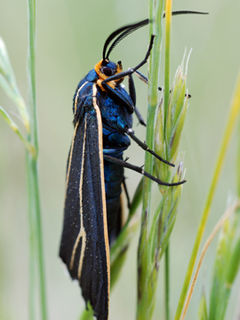
William Walker was an American physician, lawyer, journalist, and mercenary who organized several private military expeditions into Mexico and Central America with the intention of establishing English-speaking colonies under his personal control, an enterprise then known as "filibustering". Walker usurped the presidency of Nicaragua in July 1856 and ruled until May 1, 1857, when he was forced out of the presidency and the country by a coalition of Central American armies. He returned in an attempt to re-establish his control of the region and was captured and executed by the government of Honduras in 1860.

Ctenucha is a genus of moths in the family Erebidae.

Cisseps fulvicollis, the yellow-collared scape moth, is a species of the family Erebidae and subfamily Arctiinae. It was described by Jacob Hübner in 1818.

Ctenucha virginica, the Virginia ctenucha, is a moth of the family Erebidae. The species was first described by Eugenius Johann Christoph Esper in 1794.

Edith's checkerspot is a species of butterfly in the family Nymphalidae. It is a resident species of western North America and among the subspecies, entomologists have long been intrigued by their many phenotypic variations in coloration, wing length, and overall body size. Most populations are monophagous and rely on plants including Plantago erecta and Orthocarpus densiflorus as its host species in developing from eggs through to larvae, pupae, and mature butterflies. Males exhibit polygyny whereas females rarely mate more than once. Males devote most of their attention to mate acquisition, and such mate locating strategies such as hilltopping behavior has developed. Climate change and habitat destruction has impacted certain subspecies. Two subspecies in particular, Euphydryas editha quino and Euphydryas editha bayensis, are currently under protection via the Endangered Species Act.

Macroglossini is a tribe of moths of the family Sphingidae described by Thaddeus William Harris in 1839.
Emmalocera is a genus of snout moths. It was described by Émile Louis Ragonot in 1888.

Ctenucha cressonana, or Cresson's ctenucha, is a moth of the family Erebidae. The species was first described by Augustus Radcliffe Grote in 1863. It is found in the US Rocky Mountains, including Colorado and New Mexico.

Ctenucha brunnea, the brown ctenucha or brown-winged ctenucha, is a moth of the family Erebidae. The species was first described by Richard Harper Stretch in 1872. It is found in the US from central to southern coastal California.
Ctenucha quadricolor is a moth of the family Erebidae. It was described by Francis Walker in 1866. It is found on Jamaica.
Ctenucha devisum is a moth of the family Erebidae. It was described by Francis Walker in 1856. It is found in São Paulo in Brazil and in Argentina.

Ctenucha multifaria is a moth of the family Erebidae. It was described by Francis Walker in 1854. It is found in the US states of California and western Oregon.
Ctenucha rubriceps is a moth of the family Erebidae. It was described by Francis Walker in 1854. It is found in Mexico, Guatemala, Costa Rica, Colombia, Venezuela, Brazil and Uruguay.

Ctenucha rubroscapus, the red-shouldered ctenucha moth, is a moth of the family Erebidae. It was described by Édouard Ménétries in 1857. It is found in western North America, where it is limited to low elevations west of the Cascade Mountains, south of Chehalis in Washington. The habitat consists of coastal grasslands adjacent to the ocean, as well as wet boggy meadows and wet prairie.
Ctenucha ruficeps is a moth of the family Erebidae. It was described by Francis Walker in 1854. It is found in Mexico.
Ctenucha semistria is a moth of the family Erebidae. It was described by Francis Walker in 1854. It is found in Brazil.

Ctenucha venosa, the veined ctenucha moth, is a moth of the family Erebidae. It was described by Francis Walker in 1854. It is found in the US from southern Nevada and Arizona to Colorado, Kansas, Oklahoma and Texas, as well as in Mexico, Guatemala, Panama and Venezuela.
Ctenucha nana is a moth of the family Erebidae first described by E. Dukinfield Jones in 1914. It is found in Brazil.

Lycaena editha, known generally as the Edith's copper or great gray copper, is a species of copper in the butterfly family Lycaenidae. It is found in North America.










